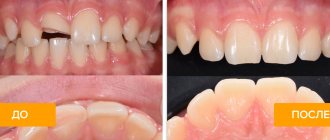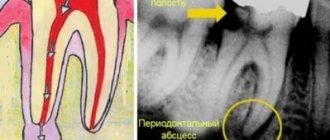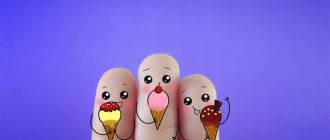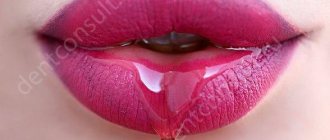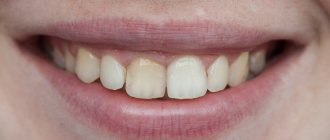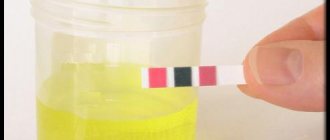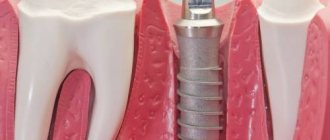Salivation is a natural physiological process that occurs throughout a person’s life. Special glands located in the oral cavity are responsible for it.
They are capable of producing about 2 liters of saliva per day. Sometimes the amount of saliva produced increases sharply, which significantly affects the quality of life. This is especially common in childhood.
Increased salivation in a child can be caused by various reasons, both natural and pathological. To understand this issue, it is necessary to consider what role saliva plays in the life of a child’s body.
Functions of saliva
Firstly, it is involved in the digestion of food, making it softer and helping it move through the esophagus. The enzymes contained in saliva are capable of breaking down starch and fats. Thus, food enters the stomach already partially digested.
Secondly, saliva plays a protective role, preventing the mouth from drying out and having a bactericidal effect. It helps to wash away food debris, and with it bacteria. Saliva neutralizes many acids and alkalis, protecting tooth enamel from their aggressive effects. It is also able to strengthen the enamel, nourishing it with important microelements (fluorine, phosphorus, calcium).
Thirdly, it helps make teething less painful by reducing inflammation in the gums. And finally, in the first months of a baby’s life, saliva has a special viscosity, which makes breastfeeding easier during natural feeding.
How to help muscles?
Exercises for the speech apparatus are useless while the muscles are too relaxed or, conversely, tense. Therefore, before classes you should massage the facial, neck and shoulder muscles. First of all, these are light strokes; sudden movements cannot be made. Lay your baby down so that his head is on your lap, at right angles to your chest. Movements are made with both hands on both sides of the face simultaneously in the following directions:
- from the middle of the forehead to the temples;
- from eyebrows to hairline;
- from the middle of the forehead along the cheeks to the neck and shoulders;
- from the earlobes through the cheeks to the nasal wings;
- from the corners of the mouth, first to the middle of the upper lip, then to the middle of the lower lip, then to the wings of the nose.
If the muscles are very tense, then the movements should be very light all the time, but if they are relaxed, then vigorous kneading and gentle stroking should be alternated.
This is general advice for parents of children with dysarthria. Specific sets of games and exercises and medications, if necessary, are selected only by a speech therapist and a neurologist, based on the characteristics of the child’s condition.
Publication date: 10/03/2019. Last modified: 01/13/2020.
Causes of increased salivation in children
Excessive drooling is scientifically called hypersalivation. In children, there are clearly visible age periods when it can occur most intensely.
Important! There is a distinction between true and false hypersalivation.
No ads 1
True hypersalivation is caused by malfunctions of the salivary glands, and false hypersalivation (also called reflex) in childhood is associated with more serious disorders in which swallowing saliva becomes less frequent.
For example, if the sensorimotor arc malfunctions, the interaction between the brain and the oral cavity is difficult. The child's number of spontaneous swallows is reduced, which creates the appearance of profuse drooling. Depending on the age, the causes of increased salivation in children may be different.
Causes of drooling can be physiological and pathological
Increased salivation (hypersalivation) in children: a problem for doctors and parents.
On the Siberian Medical Portal (https://www.sibmedport.ru) I was recently asked a question about increased drooling in a child aged 2.5 years: “Drooling constantly, not only when he starts playing or thinking and opens his mouth, but in general “Whenever you tell him and remind him that he needs to swallow his saliva, he swallows, understands this, and has been swallowing food normally for a very long time.”This pressing question is very difficult to comment on, but I will still try to answer it.
Hypersalivation, synonyms: ptyalism, sialorrhea, drooling
- This is an increase in the secretory activity of the salivary glands. In children aged the first two years of life, this phenomenon is considered physiological during the eruption of the first (baby) teeth.
In older children, hypersalivation is regarded as a disease that brings a lot of trouble, anxiety and discomfort to the child and parents.
In such children, first of all, a disturbed swallowing reflex is observed, and not a true increased production of saliva, which is commonly called hypersalivation, which is noted in the following pathological conditions:
- stomatitis (pathology of the oral mucosa);
- viral diseases affecting the salivary glands (viral sialadenitis);
- diseases of the gastrointestinal tract (pancreatitis, peptic ulcer, etc.)
- helminthic infestation;
- diseases of the central nervous system (cerebral palsy (cerebral palsy), bulbar palsy, Parkinson's disease, encephalitis of various natures (etiologies); lateral myographic sclerosis, brain tumors, strokes, some forms of schizophrenia, etc.);
- nervous stress, strong psychological and emotional experiences (positive, for example, from anticipation of something tasty, or, conversely, negative);
- poisoning with lead, mercury, barbiturates, organophosphorus substances (karbofos, chlorophos, etc.).
Clinical manifestations
are expressed in a complaint about the abundance of saliva in the oral cavity and the need to constantly spit it out.
A functional study of the salivary glands (sublingual, parotid glands) with true hypersalivation reveals an increase in the amount of secretion (saliva) above the norm of more than 10 ml in 20 minutes (normally within 1-4 ml). No other pathology of the salivary glands is determined.
“Relative” or false hypersalivation occurs against the background of a violation of the act of swallowing (with an inflammatory process in the oral cavity, injury to the tongue, neurological pathology - bulbar palsy, etc.). In these cases, the amount of saliva produced corresponds to the above standards, but the patient and parents have a false feeling of its excess.
Treatment
consists of adequate treatment of the underlying disease that caused hypersalivation.
Irritation of the mucous membrane during acute inflammatory processes occurring on the oral mucosa is accompanied by an unconditional reflex increase in saliva secretion, which is a protective reaction of the body. In such cases, hypersalivation does not require treatment.
In the treatment of true hypersalivation, drugs with an anticholinergic effect are used (m-anticholinergics - atropine, antispasmodic, typhen, aprofen, diprofen, metacin, etc.). They reduce saliva production but have other serious side effects.
M-anticholinergics include belladonna alkaloids (atropine, scopolamine) and platyphylline; synthetic drugs similar in structure (for example, homatropine) and some other tertiary and quaternary ammonium compounds (aprofen, metacin, etc.). By blocking m-cholinergic receptors in organs, these drugs cause dilation of the pupils, paralysis of accommodation, increased intraocular pressure, inhibit the secretion of saliva, sweat and secretion of the glands of the stomach and intestines, increase the rhythm of heart contractions, and relax the smooth muscles of the bronchi and stomach.
Surgical treatment and radiation are also used, but these methods threaten serious complications: facial asymmetry, caries, etc.
Treatment methods such as biofeedback therapy (biofeedback) and exercises for the muscles in this area are not effective enough to cope with the problem of ptyalism.
In children, increased salivation can cause a violation of the pronunciation side of speech - the so-called dysarthria, when a large amount of saliva prevents children from mastering and pronouncing words. This can lead to the formation of slurred speech, which will further complicate the child’s development and socialization. Therefore, this problem must be solved together with a qualified speech therapist to conduct speech therapy massage.
So, in each specific case, it is necessary to ask yourself the question: “What is the cause of increased drooling?”
P. _ S. _
From the physiology of salivation and salivation it is known that when the oral mucosa is filled with saliva, peripheral receptors transmit this information along sensory nerve fibers to the brain, and from the brain along the motor (descending) pathways the command to swallow saliva is transmitted.
Now let’s remember our feelings after visiting the dentist, who gave us light pain relief (anesthesia). It seems that if you lose sensitivity in your lips, you will begin to drool. To avoid hypersalivation, the patient has to monitor the swallowing of saliva. This effect occurs because the reflex sensorimotor arc is temporarily blocked by anesthesia, and information from the oral cavity does not enter the brain.
Drooling in children with various of the above pathologies is caused by various factors. However, they all lead to disturbances at the level of the sensorimotor arc, i.e. associated with sensory disturbances. This is the main cause of drooling.
Thus, children suffer from reduced sensation (hypoesthesia), but not anesthesia (complete loss of sensation), and therefore there are significantly fewer spontaneous swallows during the day. This explains the increased salivation.
In the presence of such hypersalivation, rehabilitation should be aimed not at regularly reminding the child of the need to voluntarily swallow saliva (especially since this cannot be done constantly), but at correcting the sensorimotor arc.
To do this, you need to create a situation to provide the brain with more information that allows for reflexive swallowing. For these purposes, foreign scientists use cryotherapy (from the Greek word krios, i.e. cold) in the form of running an ice stick across the tongue. This method of rehabilitation does not give results in 100% of cases, however, in half of the cases of hypersalivation, there is a cessation of salivation or a clear decrease in it.
Of course, this method takes quite a long time to expect a positive result (such work must be carried out over several months) and is labor-intensive for parents. However, such a conditioned reflex technique is not traumatic for the child compared to methods of surgical dental correction of facial muscles, which do not give better results over a longer period of observation.
And one last thing. If hypersalivation occurs, care should be taken to increase the child's fluid intake during the day to compensate for the daily loss of fluid (water).
02/25/2012
Timoshenko V.N.
, pediatrician of the highest qualification category,
Candidate of Medical Sciences, Associate Professor
More articles on the topic:
Newborn period
In newborn babies, salivation is normally absent due to the underdevelopment of the salivary gland apparatus. However, often a mother may notice how, in the first hours of a child’s life, a colorless liquid, very similar to saliva, is actively secreted from his mouth.
Most often, this is how amniotic fluid comes out, which the baby managed to swallow while passing through the birth canal. Normally, this phenomenon should stop a few hours after birth. If drooling continues longer, it is better to inform your pediatrician (neonatologist) about this in order to exclude serious health problems.
[node:field_field_doprekl]
How to help a child with dysarthria?
Dysarthric children with mild and moderate degrees of impairment, first of all, need regular classes with a speech therapist who knows the technique of speech therapy massage. You need to exercise at least three times a week. If you do not have the opportunity to visit a specialist, then at home you need to perform at least certain elements of speech therapy massage. In addition, the following are required:
- complex of articulatory gymnastics;
- games and exercises aimed at developing correct speech breathing (Strelnikova’s complex has proven itself well);
- finger games;
- massage to relax muscles and give them tone;
- development of fine motor skills - puzzles, mosaics, games with sand and water, modeling, drawing with colored rice, construction sets, exercises with the su-jok ring, etc.;
- general strengthening of the child’s health, in particular the nervous system.
Children with dysatria usually do well in exercises where they need to perform actions according to a model. If, for example, you are teaching a child to fasten buttons, first show it on a doll, then on yourself, then on the child’s clothes, guiding his every movement. Using the same principle, you will have to perform both articulatory gymnastics and breathing exercises: first you give the child a model, and then, under your guidance, he makes the movements independently.
Drooling at 2–3 months
At the age of about 2 months, a baby may experience profuse salivation, caused by the fact that the salivary glands finally begin to work at full capacity. It is at this age that a child may need his first bib to protect his clothes from getting wet.
The mother also needs to very carefully monitor the condition of the child’s skin, especially the area around the lips and chin. Excessive saliva can irritate baby's delicate skin. To prevent this from happening, it is recommended to lubricate the area around the mouth with baby cream or Vaseline.
Inflammation of the submandibular salivary gland
Closer to 3 months, children become active explorers of the world around them and taste everything. They put fingers, toys and any other objects at hand into their mouths.
The baby's body becomes acquainted with new microflora, which leads to increased secretion of saliva, which performs a protective function. At this age, increased saliva production can also occur against the background of an acute respiratory disease.
Breathing through the nose becomes difficult, and the child has to breathe through the mouth. This causes the nasopharynx to dry out and reflexively release a larger amount of saliva than usual, which moisturizes the air and disinfects it.
When should you contact specialists?
Typically, a dysarthric child sees a speech therapist at 4-5 years of age. This is quite late, but with proper correction and regular classes, the violation can be minimized by the time he enters first grade. The sooner you contact specialists, the higher the chances of success.
A simple test will help determine whether a child has problems with the mobility of the speech apparatus. Stand in front of the mirror, complete the tasks yourself first, then ask your child to repeat them:
- smile, and then stretch out your lips. Only the lips work, the teeth are closed, the chin does not move;
- stick out your tongue and then remove it;
- open your mouth slightly and spread your tongue on your lower lip, hold it in this position for 5 seconds;
- open and close your mouth wide, slapping your lips;
- open and close your mouth, make a tube with your lips, repeat several times;
- open your mouth, touch the corners of your mouth with the tip, move your tongue back and forth, imitating the pendulum of a clock.
Keep in mind that any conclusions can be drawn only after the child has made several unsuccessful attempts, because the first time he may not understand what is required of him. The following signs are reasons to contact a neurologist or speech therapist:
- the child cannot immediately find the right position for the speech organs;
- has difficulty holding them in a given position;
- the smile and protruding tongue seem to move to the side;
- he cannot perform individual movements;
- involuntary synchronous movements of the speech organs.
Dysarthria is also indicated by undeveloped fine motor skills, awkwardness, difficulty maintaining balance, excessive tension or relaxation of the muscles of the face and neck, and nasal pronunciation. If you notice at least two or three of the listed signs, immediately show your baby to a speech therapist and neurologist.
Teething period
Teething usually begins around 6 months of age. The child becomes whiny and irritable. The process of tooth extraction is accompanied by pain and the formation of wounds on the gums. They can greatly disturb the baby, bringing him a lot of suffering.
Salivation helps make pain less intense: saliva has an anti-inflammatory and calming effect. Teething is greatly extended over time and sometimes lasts up to 2 (and even 3) years.
[node:field_field_doprekl2]
Important! Increased salivation up to 2 years of age is most often caused by natural causes and is physiological.
Increased salivation after 5 years
If a symptom bothers a child at an older age, after 5 years, then this may be a cause for concern on the part of the parents. There are a number of reasons why saliva is produced in large quantities:
- inflammation in the oral cavity (stomatitis, gingivitis, candidiasis);
- infections of the upper respiratory tract and nasopharynx (for example, with adenoids, copious amounts of saliva are produced at night and prevent the baby from sleeping);
- disturbances in the gastrointestinal tract (gastritis, duodenitis, pancreatitis);
- helminthic infestations;
- poisoning with drugs, as well as toxic substances and household chemicals (a life-threatening condition - requires immediate medical attention);
- diseases of the nervous system (especially with damage to the central nervous system, some forms of cerebral palsy, congenital malformations).
If there is increased drooling of any etiology, it is best to show the child to a doctor. Only he will be able to determine the true cause of the symptom and, if necessary, prescribe additional examinations.
Article:
Currently, dysarthria is a widespread disorder in childhood.
For example, according to Ph.D., Associate Professor of the Department of Special Pedagogy and Psychology Vakulenko L.S. Murmansk State Pedagogical University, dysarthria occurs in 40.8% of 240 preschool children with speech pathology aged 4 to 7 years. The speech defect in question inhibits the development of speech as a whole and significantly lengthens the time required for correctional work. The purpose of this article is to consider traditional and non-traditional techniques for one of the characteristic symptoms of dysarthria - hypersalivation, i.e. profuse salivation. The problem of eliminating increased salivation is too complex and cannot be solved only through exercises in speech therapy classes.
Preliminary work
It is necessary to teach the child to suck with closed lips, swallow saliva with his head thrown back and in a normal position. Before performing any articulation exercise, the teacher reminds the child to swallow saliva and blot the inside of the mouth with a napkin.
Recommendations.
- People around you should constantly monitor the position of the child's mouth and remind him to keep his mouth closed when he is not eating or talking.
- It is important that the child develops a differentiated sensation of dry and wet chin.
- During classes, it is necessary to pause at certain intervals and invite the child to swallow saliva.
The main stage of work
1. Cryotherapy.
Applying a piece of ice along the contour of the lips, taking into account 6 points (see Fig. 1). The duration of ice retention at each point is from 5 seconds to 1 minute (V.A. Kiseleva [4]).
| Fig.1. Diagram of the location of active points in the lip area. |
2. Rinse the mouth.
- Rinse using medicinal herbs: infusion of rose hips, oak bark, yarrow. You must first make sure that your child does not have allergies.
- Step-by-step gargling with mineral water, liquid jelly, kefir, thick jelly.
3. Speech therapy massage.
- Acupressure is performed in the area of the submandibular fossa, using the index finger to make light vibrating movements under the chin for 4-5 seconds (E.F. Arkhipova [1]).
- Acupressure is performed in the recesses under the tongue, at two points simultaneously (see Fig. 2). Massage is carried out using the index, middle finger or rake probe. Rotational movements are performed counterclockwise, no more than 6-10 seconds. Movements should not cause discomfort to the child.
Fig.2. Massage in the recesses under the tongue. - Point massage. Find parallel points under the tragus of the ears, where the jaw bones meet (correctly found points are painful). With our index fingers we make circular movements along the points for 5 minutes clockwise (2.5 minutes with the mouth open, 2.5 minutes with the mouth closed) and 5 minutes counterclockwise (similar) (V.A. Kiseleva [4] ).
- Massage of the soft palate. Stroking and kneading movements with a finger along the midline of the hard and soft palate from the upper incisors to the uvula to obtain a pronounced pharyngeal reflex (V.A. Kiseleva [4]).
4. Chewing solid food.
Instructions for parents of dysarthric children:
- We gnaw, chew, swallow - carrots.
- We gnaw on crackers, bagels, dryers.
5. Static and dynamic facial and articulation exercises (E.M. Kosinova [5], O.A. Novikovskaya [7]).
- Imitation of yawning, chewing, swallowing with the head thrown back. (Chewing and swallowing is recommended to be done with the mouth closed).
- “Chicks” (“Window”). Open your mouth wide and hold it in this position for 3-5 seconds. Close your mouth. When performing the exercise, the tongue lies calmly at the bottom of the mouth. Keep your mouth open for 5-10 seconds.
- "Mustache." Hold a strip of paper, cocktail tubes of different diameters, a wooden or metal spatula, and medicine bottles of different diameters with your lips.
- "Fat guy - skinny guy." Puffing up both cheeks at the same time. Retraction of the cheeks into the oral cavity with the mouth open and lips closed.
- "Balloons". Inflate one cheek - deflate. Then inflate another and deflate. Inflate alternately 4-5 times.
- “Yogi exercise” - the mouth is open, the child rotates his tongue in front of the mouth, then the speech therapist invites him to swallow saliva.
- "Dry your tongue." Roll your tongue into a tube and suck air into yourself through the tube.
6. Activate muscles using honey or bread ball.
- Place a bread ball (crushed vitamins, drop 1-2 drops of syrup from a pipette) on the tip of your tongue, and forcefully make swallowing movements.
- Place a drop of honey on the tip of your tongue. Do the “Clock” exercise or move your tongue back and forth.
7. Breathing exercise “Storm in a glass.” Pour water into a glass. Take a juice straw and blow through it. Be careful not to puff out your cheeks.
8. Pronunciation of vowels: a, e, and on a solid attack (V.A. Kiseleva [4]).
- a a a; uh uh; and and and;
- ae, ae, ae; ea, ea, ea; ai, ai, ai; hey, hey, hey;
- aei, aei, aei.
Based on our practical experience, with systematic work, salivation disappears after 3 months.
